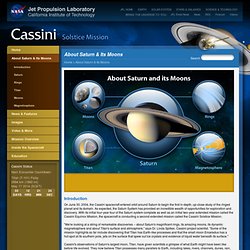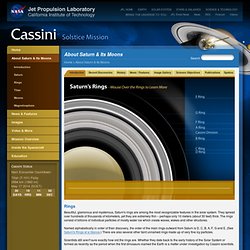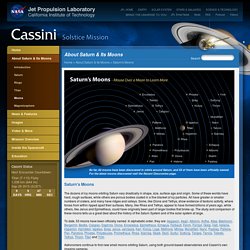

About Saturn & Its Moons. Introduction On June 30, 2004, the Cassini spacecraft entered orbit around Saturn to begin the first in-depth, up-close study of the ringed planet and its domain.

As expected, the Saturn System has provided an incredible wealth of opportunities for exploration and discovery. With its initial four-year tour of the Saturn system complete as well as an initial two-year extended mission called the Cassini Equinox Mission, the spacecraft is conducting a second extended mission called the Cassini Solstice Mission. "We're looking at a string of remarkable discoveries -- about Saturn's magnificent rings, its amazing moons, its dynamic magnetosphere and about Titan's surface and atmosphere," says Dr. Linda Spilker, Cassini project scientist. Cassini's observations of Saturn's largest moon, Titan, have given scientists a glimpse of what Earth might have been like before life evolved. Why the "Cassini Solstice Mission? " Science Objectives. Rings. Rings Beautiful, glamorous and mysterious, Saturn's rings are among the most recognizable features in the solar system.

They spread over hundreds of thousands of kilometers, yet they are extremely thin – perhaps only 10 meters (about 30 feet) thick. The rings consist of billions of individual particles of mostly water ice which create waves, wakes and other structures. Named alphabetically in order of their discovery, the order of the main rings outward from Saturn is D, C, B, A, F, G and E. (See Saturn's Rings at a Glance.) Scientists still aren't sure exactly how old the rings are. Whenever they first formed, it is clear that the rings we observe today were not all created in exactly the same way.
The spacecraft began returning valuable information about the rings even before it slipped into Saturn orbit in July 2004. "The images found evidence for new processes whereby particle sticking and self gravity interact to form structures never seen before," explains Dr. Magnetosphere. Magnetosphere Forces deep inside Saturn create a giant magnetic bubble around the planet, called the magnetosphere, which exerts a powerful influence on particles that float through space near the planet.

Saturn's magnetic field creates this bubble as material cycles deep within the planet's fluid interior. In a similar way, Earth's magnetic field creates a much smaller magnetosphere that protects us from harmful particles emitted by the sun and other space phenomena. Outside Saturn's magnetosphere, a million-mile-per-hour gale of particles from the sun, called the solar wind, spreads out through the Solar System. When the solar wind encounters Saturn's magnetosphere, it streams around it, like a stream around a rock. Saturn's magnetic field has north and south poles, like those on a bar magnet, and the field rotates with the planet.
Saturn's Moons. Saturn's Moons The dozens of icy moons orbiting Saturn vary drastically in shape, size, surface age and origin.

Some of these worlds have hard, rough surfaces, while others are porous bodies coated in a fine blanket of icy particles. All have greater or smaller numbers of craters, and many have ridges and valleys. Some, like Dione and Tethys, show evidence of tectonic activity, where forces from within ripped apart their surfaces. Many, like Rhea and Tethys, appear to have formed billions of years ago, while others, like Janus and Epimetheus, could have originally been part of larger bodies that broke up. To date, 53 moons have been officially named. Astronomers continue to find new small moons orbiting Saturn, using both ground-based observatories and Cassini's own imaging cameras. For more information on the latest moons discovered visit the Recent Discoveries page and the Icy Satellites publications listing. Diversity of Worlds The moons of Saturn are a diverse collection.
Titan.